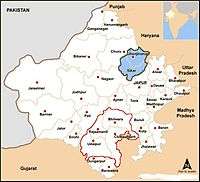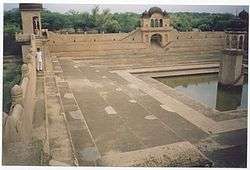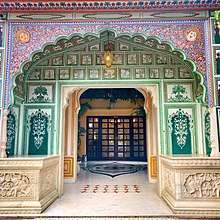Shekhawati
Shekhawati is a semi-arid historical region located in the northeast part of Rajasthan, India.
|
Historical Region of North India | |
.jpg) | |
| Location | Northern Rajasthan 27°55′N 75°24′E |
| 19th-century flag Shekhawati Princely State |
|
| State established: | 1445 |
| Language | Shekhawati |
| Dynasty | Shekhawats (1445-1948), branch of Kachawa Dynasty of Jaipur |
| Historical capitals | Amarsar, Shahpura |
| Separated states | |
Shekhawati is located in North Rajasthan comprising districts of Jhunjhunu, Sikar, Churu and a part of Nagaur and Jaipur. It is bounded on the northwest by the Jangladesh region, on the northeast by Haryana, on the east by Mewat, on the southeast by Dhundhar, on the south by Ajmer, and on the southwest by the Marwar region. Its area is 13784 square kilometers.[1]
History has it that in the 17th to 19th centuries, Marwari merchants constructed these grand havelis in the Shekhawati region. Steeped in wealth and affluence, these merchants got busy outdoing others in building more grand edifices – homes, temples, step wells which were richly decorated both inside and outside with painted murals.[2]
Etymology of Shekhawati
Shekhawati was first mentioned in the book Bankidas ki Khyat.[3] Contemporary of Bankidas was Colonel W.S. Gardener, who used the word Shekhawati in 1803. Later James Tod wrote the first history of Shekhawati. The term Shekhawati was used frequently in Vamsh Bhaskar. This suggests that the term came in use about two and half centuries ago.[4] Shekhawati is named after Rao Shekha.
Geography

Shekhawati is in the Thar Desert of Rajasthan and has special importance in the history of India.
The climate of the desert region is harsh and extreme. The temperature ranges from below 0 °C (32 °F) in winter to more than 50 °C (122 °F) in summer. The summer brings hot waves of air called loo. Annual rainfall is at around 450 to 600 mm. The groundwater is as deep as 200 feet (60 m), and in some places, the groundwater is hard and salty. The people in the region depend on rainwater harvesting. The harvested rainwater from the monsoon season (during July and August) is stored in pucca tanks and used throughout the year for drinking purposes.[5]
Shekhawati dialect
Shekhawati is a dialect of the Rajasthani language and is spoken by about three million speakers in the Churu, Jhunjhunu, and Sikar districts of Rajasthan. Even though it is a very important dialect from the grammatical and literary points of view, very little work is carried out on it. In 2001 a descriptive compendium of the grammar of Shekhawati was published.[6] Shekhawati, like the Bagri dialect of Ganganagar and Hanumangarh districts, has a parallel lexicon which makes it very rich from the lexicographical point of view. Word order is typically SOV and there is an existence of implosives. The presence of high tone at suprasegmental level classifies it with other dialects of Rajasthani. It has contributed a lot to the development of Rajasthani language and linguistics.
Some samples in Shekhawati are:
- Kai Hoyo? कै होयो? = What happened?
- The Kai kar rieya ho? थे कै कर रिया हो?= What are you doing?
- Ma Thane ghano samman desyu. मैं थाने घणो सम्मान देस्यु = I will give you great respect.
- The sidh ja riya ho? थे सिद्ध जा रिया हो?= Where are you going?
- The ke kha rahiya ho? थे के खा रहिया हो? = What are you eating?
History
Ancient history
Many historians have considered this region included in the Matsya Kingdom. Rigveda also provides certain evidences in this matter.[7][8] Manusmriti has called this land as 'Brahmrishi Desha'.[9]
Shekhawati region was included in 'Marukantar Desha' up to Ramayana period. Out of 16 mahajanapadas prior to Buddha, only two Janapadas, namely Avanti and the Kingdom of Virata were counted in Rajasthan area. This region was also influenced by Avanti but later on Nandas of Magadha defeated Avanti. Historians believe that Mauryas obtained the Rajasthan from Nandas.[10]
In ancient times Shekhawati was not limited to the present two districts. During the Mahabharata period, it was known as Matsya Kingdom and extended to the Sarasvati River. This was because the first clan ruling this region, in the Mahabharata period, were descendants of fishermen. So the Vedas were supposed to be written and compiled on this very land.[11][12] During ancient times this region was divided into several janapadas. Every Janapada was a free republic state. The development of Janapadas in Rajasthan started with habitation of Aryan.[13] The northern part of Rajasthan was known as Jangladesh (Bikaner and Nagaur) during Mahabharata period.[14] and eastern part Jaipur-Alwar were called the Matsya Kingdom. Pandavas had spent one year of their vanishment in this Kingdom of Virata as their abode, to live in anonymity, after the expiry of their twelve-year-long forest life.[7] Dhosi Hill, the revered Hill, bordering Haryana, famous for Chyavana Rishi's Ashram, and place where Chyawanprash was formulated for the first time has extensive mentions in the epic Mahabharat in Vanparv. According to Vimal Charanlal, this Kingdom of Virata extended from Jhunjhunu to Kotkasim 109 km in the north, Jhunjhunu to Ajmer 184 km in the west, Ajmer to Banas and up to the confluence of Chambal River 229 km in the south. The capital of this Kingdom of Virata was Bairat.[11][15]
After the collapse of Gupta dynasty, Shekhawati's some parts like Jhunjhunu, Fatehpur, Narhar were controlled by the Kaimkhanis, until they were defeated by Shekhawat Rajputs.
Kaimkhani is a branch emerged from Chauhans. The first progenitor of Kaimkhanis was Karamchand, born in the family of Moterao of Chauhan clan, the ruler of Dadrewa. Firuz Shah Tughluq converted him to Islam and named him Kaimkhan. Thus his descendants are called Kaimkhani.
Shekhawat rule

Shekhawati was established and ruled by Shekhawat Rajputs until India's independence.
Rao Shekha from Dhundhar established his own independent kingdom with the capital at Amarsar. He was the first independent ruler. After him, Rao Raimal, Rao Suja, and Rao Lunkaran become the rulers of Amarsar. Rao Manohar succeeded his father Rao Lunkaran and founded Manoharpur later renamed Shahpura (The present ruler of Shahpura is the Tikai of Shekhawat subclan). Shekhawats conquered the Jhunjhunu, Fatehpur, Narhar of Kaimkhanis and established their rule in 1445 and ruled till 1614.[16]
Thikanas of Shekhawati

Rao Shekha, a Shekhawat Rajput (sub-branch of Kachwaha or Kushwaha), was the founder of Shekhawati, who originally divided Shekhawati into 33 Thikana (also called a Pargana), each with at least a 'kuccha' mud fort, some of which were fortified further with stone. Many Thikanas had their own flags and emblems. Shekhawats ruled over the largest number of Thikanas in Jaipur Rajwara.
- Shahpura Thikana, the Head Seat of Shekhawat Clan. Shahpura was a Tazimi Thikana of Shekhawat Sub Clan and was Granted by Rao Shekha to his youngest son Rao Lunkaran.[17][18]
- Khachariawa Thikana was granted to Raja Raisal's eldest son Thakur Lal Singh. As Akbar called Lal Singh Lad Khan, this name became famous, and his descendants are known as Ladkhani|Khatu Thikana]] was granted to Raja Raisal's second son Kesari Singh.
- Udaipurwati Thikana was granted by Raja Raisal to his fifth son Rao Bhojraj. Rao Bhojraj was the ancestor of the Bhojraj Ji Ka branch of Shekhawats. His descendants founded many Thikanas and ruled over them. The group of 45 villages of Udaipurwati was known as Pentalisa), that included Jhajhar, Gudha, Sultana (Rao Hathi Ram Singh ji ka), Khirod, etc.
- Nangali Saledi Singh Thikana was granted by Rao Bhojraj to his youngest son Thakur Saledi Singh Shekhawat.
- Bissau Thikana, Bissau and Surajgarh merged to form Bissau
- Dundlod Thikana
- Jhunjhunu Thikana
- Khandela Thikana
- Kansarda Thikana Kanak Singh Ji
- Khatushyamji Thikana
- Mandawa Thikana
- Mukundgarh Thikana
- Mundru Thikana
- Nawalgarh Thikana
- Parasrampura Thikana
- Pentalisa Thikana
- Pilani Thikana
- Sikar Thikana
- Surajgarh Thikana
Culture, heritage, and tourism

Architecture
Shahpura Haveli, A 300 hundred year old Palace was built by Rao Pratap Singh, Descendant of Rao Shekha in the 17th Century. In the zenana (women's quarters), various rooms offer different themes. One room has antique murals, another has a marble fountain, while the turret room has walls that are 7 feet (2.1 m) thick. Diwankhana, the formal drawing room, is decorated with family portraits and an array of antique armour. The Haveli was then renovated by Maharaj Surendra Singh and is now running as a Heritage Hotel. The Haveli got recognized as one of the Historic Hotels in the World in the Year 2018.[19]
Havelis, temples and frescos
Most of the buildings of the Shekhawati region were constructed in between the 18th century and the early 20th century. During the British occupation, traders adapted this style for their buildings.[20] The havelis are noted for their frescos depicting mythological and historical themes. The frescos include images of gods, goddesses, animals, and the life of the lords Rama and Krishna, profusely painted on the havelis in this region. Shahpura Haveli in Shahpura, 65 km from Jaipur on Jaipur - Delhi Highway and Nangal Sirohi in Mahendragarh district, 130 km from Delhi are popular for their Shekhawati architecture within NCR.[21]
Feudalism
Feudalism functioned as an over-riding politico-administrative, social and economic formation undermining even the institution of caste. The feudal mode of social relations as a dominant force guided the everyday life of the people of the Shekhawati region in Rajasthan. One could trace some continuity of the past social formation in eastern Uttar Pradesh, Bihar and Bengal in the form of "semi-feudalism"as characterised by some scholars, but such a situation is not evident in present-day Rajasthan, which was a prominent stronghold of feudalism prior to independence.[22]
Today a remarkable discontinuity in distributive processes and social relations, the simultaneous occurrence of the processes of upward and downward social mobility and a self-perpetuating process of social transformation could be witnessed in Shekhawati.[22]
Farmers
The Shekhawati region has the highest literacy in the state.[23] The predominant farming communities in the rural areas of Shekhawati are the Jats: they comprise the largest single caste in the state (9 percent), and were, in the 1930s and even earlier, the most self-conscious and prosperous among the peasant castes. They have also been the largest source of income for the region and its rulers. In 1935 their claims to certain privileges led to a series of clashes between them and the Rajputs, who resisted their attempts to revise accepted signs of status.[24]
Before independence, the farmers of the Shekhawati region were exploited and oppressed by the Jagirdars during British Raj. During that time, Jagirdars would burden farmers, known as Kisans, with various taxes, a large part of which was to be paid to the British government.
Education
Recently, the Shekhawati region has shown immense growth in the education sector and has become one of the most successful belt in terms of merit results. There are many schools and colleges that have established which is the prime reason of the huge success the region is seeing. Shekhawati is even used for name keeping of the institutes like Shekhawati Public School, Dundlod, Shekhawati Engineering college etc. There are many institutes named after Shekhawati.
See also
- Rajasthani people
- Ramgarh Shekhawati
- Shahpura, Jaipur
References
- Taknet, D.K, Marwari Samaj Aur Brijmohan Birla, Indian Institute of Marwari Entrepreneurship, Jaipur, 1993 p 78 ISBN 81-85878-00-5
- Aditya Mukherjee, "Art through the lens: Havelis of Shekhawati", The Times of India (Nov 12, 2013)
- Mukutji: Jaipur rajya ka bhugol, page 46-47
- Sahiram: Ek adhūrī krānti, Shekhawati kā kisān āndolan (1922-1952), page-1
- Busquet, Carisse and Gerard Impressions of Rajasthan 2003, Editions Flammarion, ISBN 2-08-011171-X
- Lakhan Gusain. Shekhawati. Munich: Lincom Europa (2001) (LW/M 385)
- G H Ojha: Rajputane ka Itihasa (Part I), page 83
- Sukh Sampati Raj Bhandari: Bharat ke deshi Rajya, Jaypur Rajya ka Itihas, page 3
- Sahiram: Ek adhūrī krānti, Shekhawati kā kisān āndolan (1922-1952), page-3
- Prithvi Singh Mehta: Hamara Rajasthan (1950), pages 30-31
- Sahiram: Ek adhūrī krānti, Shekhawati kā kisān āndolan (1922-1952), page-2
- Satapatha Brahman 13/5/9
- Prithvi Singh Mehta: Hamara Rajasthan (1950), page 27
- Prithvi Singh Mehta: Hamara Rajasthan (1950), page 28
- G H Ojha: Rajputane ka Itihasa (Part I), page 86
- Hooja, Rima (2006). A History of Shekhawats. Rupa & Company. p. 397.
- Hooja, Rima (2006). A History of Rajasthan. Rupa & Company. p. 499.
- Hooja, Rima (2006). A History of Rajasthan. Rupa & Company. p. 689.
- Haveli, Shahpura (12 January 2018). "Shahpura Hotels". Condé Nast Traveller India.
- Henderson, Carol D, Cultures and Customs of India; Greenwood Press 1992, ISBN 0-313-30513-7, pg. 92
- Magnificent havelis of Nangal-Sirohi, The Tribune, 22 June 2002.
- K.L. Sharma: Caste, Feudalism and Peasantry: The Social Formation of Shekhawati, Vedams eBooks (P) Ltd. New Delhi, 1998
- Dr RP Arya, Jitendra Arya, Gayatri Arya, Anshuman Arya, Rajasthan Road Atlas, Indian Map Service, Jodhpur 2005
- Princely States Report Archived 16 December 2012 at Archive.today
External links
Further reading
- Ranbir singh Shekhawat(DUNDLOD) History of Shekhawats,Jaipur,2001 ISBN 81-86782-74-5
- Ghansyamdas Birla: Bikhare Vicharon ki Bharonti, New Delhi, 1978
- Rajasthan: the painted walls of Shekhavati, by Aman Nath and Francis Wacziarg. Vikas Publications, 1982. ISBN 0-7069-2087-2.
| Wikivoyage has a travel guide for Shekhawati. |
